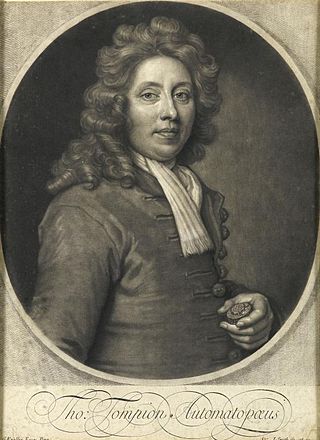Related Research Articles

1663 (MDCLXIII) was a common year starting on Monday of the Gregorian calendar and a common year starting on Thursday of the Julian calendar, the 1663rd year of the Common Era (CE) and Anno Domini (AD) designations, the 663rd year of the 2nd millennium, the 63rd year of the 17th century, and the 4th year of the 1660s decade. As of the start of 1663, the Gregorian calendar was 10 days ahead of the Julian calendar, which remained in localized use until 1923.

Christiaan Huygens, Lord of Zeelhem, was a Dutch mathematician, physicist, engineer, astronomer, and inventor who is regarded as a key figure in the Scientific Revolution. In physics, Huygens made seminal contributions to optics and mechanics, while as an astronomer he studied the rings of Saturn and discovered its largest moon, Titan. As an engineer and inventor, he improved the design of telescopes and invented the pendulum clock, the most accurate timekeeper for almost 300 years. A talented mathematician and physicist, his works contain the first idealization of a physical problem by a set of mathematical parameters, and the first mathematical and mechanistic explanation of an unobservable physical phenomenon.

Robert Hooke was an English polymath who was active as a physicist, astronomer, geologist, meteorologist and architect. He is credited as one of the first scientists to investigate living things at microscopic scale in 1665, using a compound microscope that he designed. Hooke was an impoverished scientific inquirer in young adulthood who went on to become one of the most important scientists of his time. After the Great Fire of London in 1666, Hooke attained wealth and esteem by performing more than half of the property line surveys and assisting with the city's rapid reconstruction. Often vilified by writers in the centuries after his death, his reputation was restored at the end of the twentieth century and he has been called "England's Leonardo [da Vinci]".

Sir Christopher WrenFRS was an English architect, astronomer, mathematician and physicist who was one of the most highly acclaimed architects in the history of England. Known for his work in the English Baroque style, he was accorded responsibility for rebuilding 52 churches in the City of London after the Great Fire in 1666, including what is regarded as his masterpiece, St Paul's Cathedral, on Ludgate Hill, completed in 1710.
This article contains information about the literary events and publications of 1742.
This article contains information about the literary events and publications of 1656.
This article contains information about the literary events and publications of 1612.

Ernst Florens Friedrich Chladni was a German physicist and musician. His most important work, for which he is sometimes labeled the father of acoustics, included research on vibrating plates and the calculation of the speed of sound for different gases. He also undertook pioneering work in the study of meteorites and is regarded by some as the father of meteoritics.

The year 1820 in science and technology involved some significant events, listed below.
The year 1742 in science and technology involved some significant events.
The year 1660 in science and technology involved some significant events.
The year 1662 in science and technology involved some significant events.
The year 1657 in science and technology involved some significant events.
A grandfather clock is a tall, freestanding, weight-driven pendulum clock, with the pendulum held inside the tower or waist of the case. Clocks of this style are commonly 1.8–2.4 metres (6–8 feet) tall with an enclosed pendulum and weights, suspended by either cables or chains, which have to be occasionally calibrated to keep the proper time. The case often features elaborately carved ornamentation on the hood, which surrounds and frames the dial, or clock face.

Thomas Tompion, FRS (1639–1713) was an English clockmaker, watchmaker and mechanician who is still regarded to this day as the "Father of English Clockmaking". Tompion's work includes some of the most historic and important clocks and watches in the world, and can command very high prices whenever outstanding examples appear at auction. A plaque commemorates the house he shared on Fleet Street in London with his equally famous pupil and successor George Graham.
Events from the year 1739 in Great Britain.
Events from the 1480s in England. This decade marks the beginning of the Tudor period.

The history of timekeeping devices dates back to when ancient civilizations first observed astronomical bodies as they moved across the sky. Devices and methods for keeping time have gradually improved through a series of new inventions, starting with measuring time by continuous processes, such as the flow of liquid in water clocks, to mechanical clocks, and eventually repetitive, oscillatory processes, such as the swing of pendulums. Oscillating timekeepers are used in modern timepieces.

Emery Molyneux was an English Elizabethan maker of globes, mathematical instruments and ordnance. His terrestrial and celestial globes, first published in 1592, were the first to be made in England and the first to be made by an Englishman.

Nathaniel Hooke was an English historian.
References
- ↑ Leupe, Pieter Arend Leupe (1868). "De eilanden Dina en Maerseveen in den Zuider Atlantischen Oceaan" in: Verhandelingen en berigten betrekkelijk het zeewezen, de zeevaartkunde, de hydrographie, de koloniën en de daarmede in verband staande wetenschappen, Deel 28, Afd. 2, [no.] 9 (Amsterdam) pp. 242–253.
- ↑ Katz, V. J. (2009). A History of Mathematics: An Introduction (3rd ed.). Boston, Mass.: Pearson Education. p. 488.
- ↑ Espinasse, Margaret (1956). Robert Hooke. London: Heinemann. p. 50. OCLC 459411551.
- ↑ Reid, Thomas (1832). Treatise on Clock and Watch-making, Theoretical and Practical. Philadelphia, Pa: Carey & Lea. p. 184.
- ↑ Beckett, Edmund (1874). A Rudimentary Treatise on Clocks and Watches and Bells (6th ed.). London: Lockwood. p. 71.
- ↑ Usher, Abbott Payson (1988). A History of Mechanical Inventions. New York: Courier Dover. p. 313. ISBN 0-486-25593-X.
- ↑ The clock is in the Irish Museum of Time. "Museum of Time..." Irish Independent. Dublin. 2024-03-28. Retrieved 2024-09-26.